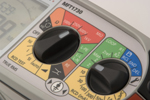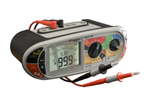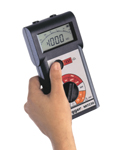
For most electrical contractors,continuity testing is such a simple and basic test that it hardly counts when they're making a decision about which test set to buy.That's a big mistake,says Simon Wood of Megger,who explains how having the right continuity test features makes an instrument more convenient to use and saves a lot of valuable testing time.
Continuity testing–there's not much too it,is there?It's easy to understand this point of view.After all,continuity testing is a lot more straightforward than,say,loop testing or testing RCDs.It's wrong,however,to think that continuity testing is unimportant or that all instruments offer continuity test facilities that are pretty much the same.And it's worth bearing in mind that continuity tests are the tests carried out most frequently by contractors,which means that even just a few seconds shaved off each test quickly adds up to a significant overall time saving.
Let's start,therefore,by looking at some of the factors that can affect testing speed.The first is auto-start testing,which simply means that,when the instrument is set to a continuity range,it starts measuring as soon as the test probes are applied to the circuit under test,without the user needing to press a start button.Not only is this a big time saver,it also makes the instrument much easier to live with.Having to start every test manually soon becomes very annoying!

Another useful time saver is a lead null memory.It's important to null out the resistance of the test leads before carrying out continuity tests where accurate results are needed,as they are,for example,when certifying an installation.With a good lead set,however,the resistance of the leads will stay the same for long periods,so nulling once a day should be perfectly adequate,provided that the instrument has a lead null memory to store the resistance of the test leads.
Some of the time,electrical contractors are not necessarily looking for an accurate resistance reading when carrying out a continuity test;all they need to know is whether or not they have continuity.In these cases,a buzzer function saves a lot of time,but only if the buzzer has a fast response.A user-adjustable resistance threshold for the operation of the buzzer can also be very useful.
Now let's have a look at some factors that affect testing convenience more than speed.First,remember that continuity tests that are going to be used for installation certification must be carried out at a current of 200 mA,with a dc test voltage between 4 V and 24 V.To ensure that these conditions are being met,it's useful to have an instrument that gives not only a resistance reading,but simultaneously displays the actual test current in use.
An open-circuit voltage of at least 4 V is necessary to overcome any microscopic oxide layers present,but once the test is initiated,oxides burn through and this voltage collapses to a few millivolts across the circuit under test.It is essential to pick a tester that has a regulated 200 mA output,as otherwise as the batteries become low,the test current could also collapse and this would mean that the test would not be in accordance with the regulations.
Some continuity tests are,however,not carried out for certification purposes.There's no problem,of course,in carrying out these non-certification tests with a test current of 200 mA,but using such a high current means that the battery in the tester may run down much more quickly.It's very useful,therefore,if the tester has a low current continuity option–say 20 mA test current–that can be used for everyday testing,as this can extend battery life.
Another option is to select a tester that uses long-life rechargeable batteries as,in the long run,these are much more economical than continually buying replaceable batteries.Even with a tester of this type,however,the low current continuity testing option is useful,as it will extend the operating time before the batteries need recharging.

There are some really important features that relate to safety.For use on electrical installations,a continuity tester should ideally have a CAT IV 300 V safety rating,which means that it's safe to use on any part of the installation.This may,at first,seem unnecessary,as a continuity tester is a dead-circuit tester.It is far from unknown,however,for continuity testers to be accidentally connected to live circuits,so the CAT IV 300 V safety rating is relevant and needed.
In addition,the continuity tester must be designed so that it can safely withstand accidental connection to a live circuit.With the best instruments,this will simply generate a warning and inhibit the test–the instrument will be undamaged and can continue to be used,which is a very big benefit.Replacing a damaged instrument can waste a lot of money and valuable time!
By now,this article should have provided all of the information needed to select a good continuity tester.Suppose,however,that you've followed the advice and bought a good tester,but you're not happy with results you're getting,especially after you've been using it for a while.If this happens,it's worth remembering that the vast majority of problems with continuity testers are caused not by the testers themselves,but by the test leads.
Poor crocodile clips or clips with weak springs may,for example,not grip tightly.This not only shows as unstable measurements because of the poor connection to the circuit under test,but can also make it impossible to null the leads accurately,which potentially means that every reading will be incorrect because the wrong compensation for the lead resistance will be applied.
Another important point to watch out for is a tired fit between the plugs on the test leads and the instrument.As continuity tests involve readings down to tenths of an ohm,a poor connection between the plug and the instrument can make a big difference to test results.This problem is,in fact,the most common cause of complaints about instruments that appear to give inconsistent results,but can easily be remedied with a new set of leads.
As we've seen,continuity testing most certainly does count when choosing a new instrument and,when you're looking for a new tester,it's very worthwhile selecting one that meets the requirements that have been discussed in this article.You'll be glad you did because over the many years of service a reliable instrument will give,choosing the right tester will save you a lot of time,money and frustration!





